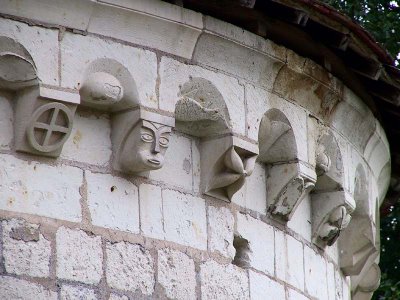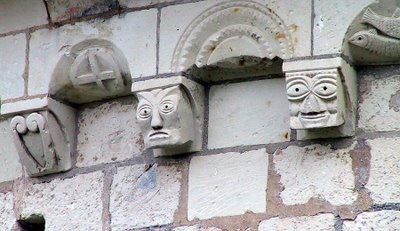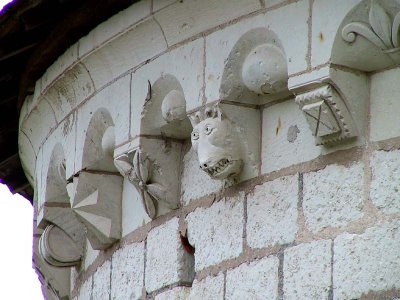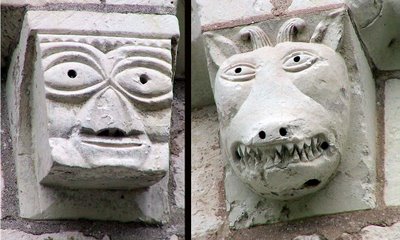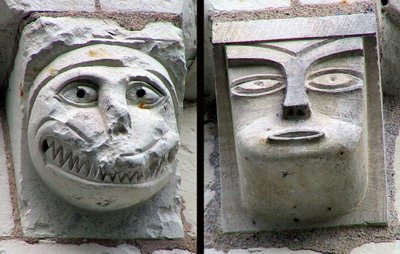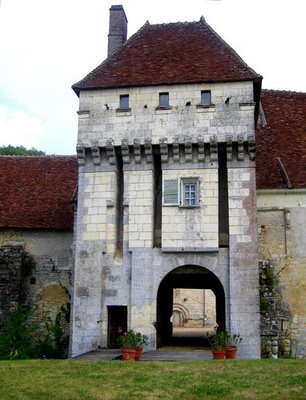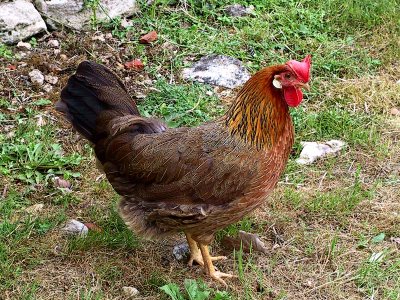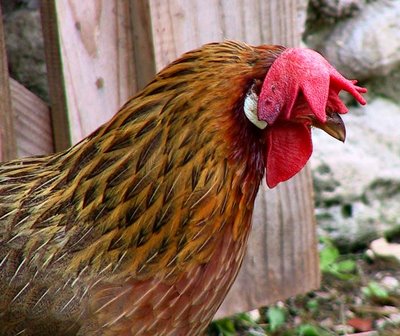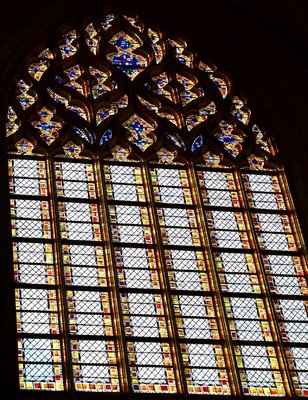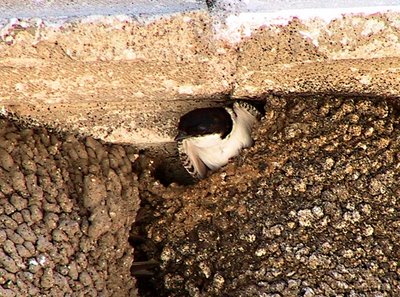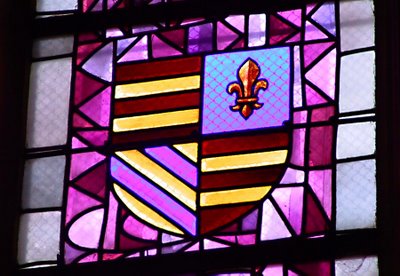I started this topic a week ago but have been too busy to finish it. Now Walt has posted his Saumur entry. I apologize if this duplicates parts of his post. I just can’t keep up these days.
* * *
Last Tuesday we decided to drive over to Saumur to see the château there and some other sights. We also wanted to see the town itself and then drive west along the Loire about 7 miles to see the Romanesque church in the village of Cunault. On the way home late in the afternoon, we would go buy some wine in the Saumur-Champigny wine district.
 Butcher shop in old Saumur
Butcher shop in old SaumurSo that’s what we did. We left Saint-Aignan in our little Peugeot at about 9:00 a.m. and headed for Loches, Sainte-Maure-de-Touraine, and Chinon, on the way to Saumur. We thought it would be better to go around far south of the city of Tours rather than drive through it or its suburbs.
 Château de Brétignolles
Château de BrétignollesThe weather this July has been very hot, though not as extreme as it was in 2003. The temperature has been 90 or above every day for about two weeks. The car is air-conditioned, while the house is not, so driving around the countryside is a good way to escape the heat.
We took the narrow back roads down to Orbigny and then on through Genillé to the bigger town of Loches (pop. 8,000 or so). From there it was a straight shot for about 20 miles. At the little town of Tavant, just past Sainte-Maure, we stopped to see if we could look around in the village church. Unfortunately, the doors were locked.
Next we drove past the château de Brétignolles and then took a little detour to see the château du Rivau. Both of these are near the village of Sazilly, not more than 10 miles southeast of Chinon (pop. 8,000 also).
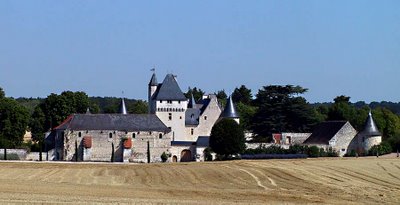 Château du Rivau
Château du RivauWe finally arrived in Saumur at about 11:30, just in time for lunch. We had looked at the Michelin green guide and found a restaurant recommendation there. La Petite Auberge, on the square just in front of the Eglise Saint-Pierre, looked like just the right place for a good noontime meal.
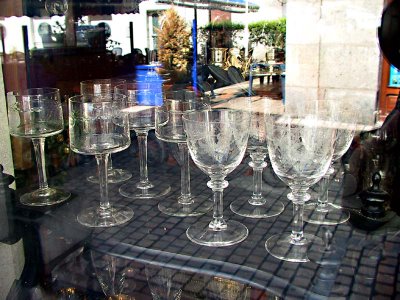 Antiques in a shop window in Saumur
Antiques in a shop window in SaumurFor the sake of comparison, and because we had a little extra time, we examined the menus displayed outside several other restaurants and cafés on the Place St-Pierre. None measured up. La Petite Auberge had a nice outdoor seating area and the menu, featuring classic French specialities, was extensive. At 17.50 euros per person, it looked like a bargain too.
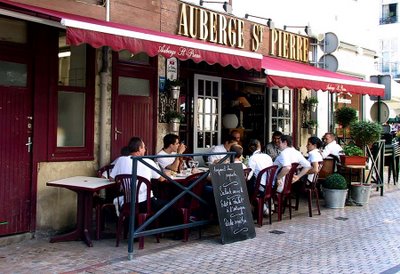 Staff lunch at La Petite Auberge in Saumur
Staff lunch at La Petite Auberge in SaumurThe restaurant is on a corner and has entrances and tables on a side street as well as on the square in front of the church. On the side street patio we saw a group of young people dressed in black and white having their lunch. It was the restaurant staff, getting ready for the lunch service to come.
We asked the people at the staff lunch what time they started serving lunch, and they said noon. We wandered around the place for a few minutes more. At noon, we went and occupied a table on the larger patio area on the
place.
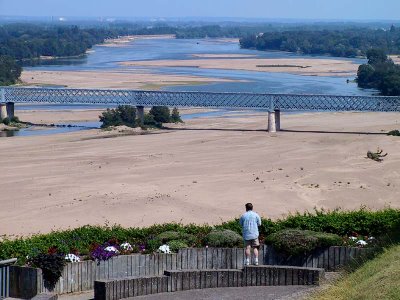 Walt couldn't have taken this picture of the sandy bed
Walt couldn't have taken this picture of the sandy bed
of the Loire River, because he's in it.Walt and our friend CHM ordered a salmon terrine as their
entrée. They both said it was good. Despite the searing heat and the fact that July is an R-less month, I decided to have a half-dozen oysters as my appetizer. They were salty and fresh, served with a
mignonette (vinegar, shallots, and pepper) and fresh butter with slices of rye bread. I enjoyed them and had no regrets (even 36 hours later, if you know what I mean).
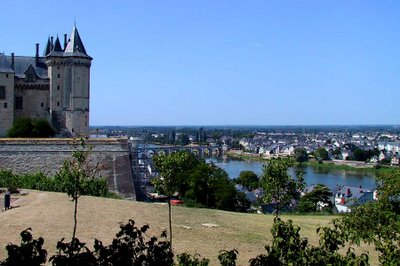 Château de Saumur
Château de SaumurWe had a half bottle of local Saumur white wine (
chenin blanc) with the appetizers, and it was fruity and fresh and not too dry. It went well with the saltiness of the oysters.
Walt had grilled
rouget barbet (redfish?) filets for his lunch, served with a pile of sauerkraut. He said it was excellent. CHM had
bœuf bourguignon. I decided to be daring and try the
tête de veau with
sauce gribiche. That’s meat cut from the calf’s head. I like
fromage de tête (head cheese), which is made from the meat picked off the pig’s head, so I thought it would be good. A French woman I had had lunch with a few days earlier in a different restaurant had ordered it, and it looked good on her plate.
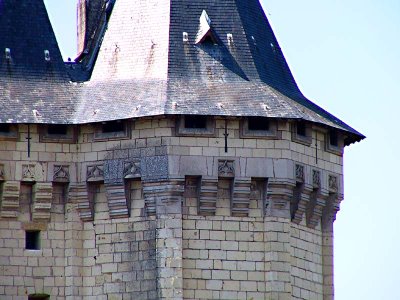 Saumur château detail
Saumur château detailWell, I think it was a mistake for me to choose it. It was too fatty and gelatinous for me and in the hot weather it was a little
écœurant (too rich). It was very different from what I had seen at the other restaurant a few days before. I ate the leaner pieces of meat but ended up leaving a lot of the portion on the plate. I left so much, in fact, that the waiter who came to clear the table asked me if it had not been good. I just made an excuse about the hot weather, my lack of appetite, and the copious portion I had been served.
With lunch we had a bottle of Saumur-Champigny red wine that was just excellent. That was a good omen for the wine-buying excursion we had planned for later in the day.
 Saumur, the old bridge
Saumur, the old bridgeAfter lunch we stopped in the Maison du Vin at the tourist office to ask where we might buy some Saumur-Champigny wine in bulk, the way we buy it around Saint-Aignan. We had our four 10-liter jugs in the trunk of the Peugeot. The man at the wine center gave us the names and addresses of a wine producer called Domaine des Champs Fleuris in the village called Turquant and of a cooperative in the village of Saint-Cyr-en-Bourg. He said not too many wineries would still have 2005 wine to sell in bulk — most would have bottled it all by now — but those two would.
After a quick visit to the church at Cunault (more about that in another post, maybe), we went to Turquant and bought 20 liters of red (2005
cabernet franc). We had to drive past the main entrance of the winery, turn right on a side road, and find the owner in his wine-making facility. I opened a door and there he was running the bottling machine.
Dressed in shorts, a t-shirt, and sandals, he greeted us with a smile and said buying wine was no problem. We went back down the road to the main entrance, us driving and him walking. He took us into a cave where barrels lined the walls as far back as we could see. The temperature in the cave must have been 30 degrees F cooler than outside. The thick, fruity Saumur-Champigny
cabernet franc was 3.30 euros a liter (less than $3.00 a bottle).
We drove on to Saint-Cyr, following signs to the Cave Cooperative des Vignerons de Saumur. Champs Fleuris didn’t sell white wine in bulk, and I wanted some. As we drove into Saint-Cyr, I had a blue
gendarme vehicle right on my back bumper, so I was trying to be careful not to speed or break any rules. Of course that made me nervous and I took a wrong turn.
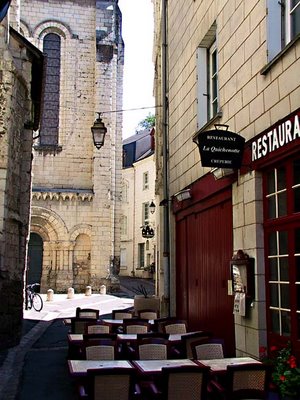 Old Saumur, cafés near the Eglise St-Pierre
Old Saumur, cafés near the Eglise St-PierreThe wrong turn got the gendarme off my tail and we didn’t have too much trouble finding the wine coop anyway. There again the people were all smiles. A young woman who said she had lived all over France — Metz, Bordeaux, Toulouse, Normandy, Paris, and on and on (I told her she must be about 80 years old to have done all that but didn’t look it) — gave us two white wines to taste. One was a
vin de pays at 1.70€ a liter, and the other an AOC at 2.20€. Both were
chenin blanc, and both were (are) delicious. I bought 10 liters of each.
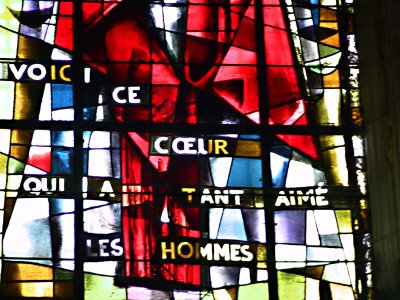 Stained glass in the Eglise St-Pierre in Saumur
Stained glass in the Eglise St-Pierre in SaumurAfter getting the wine, we drove on back toward Saint-Aignan, making short stops in the towns of Montreuil-Bellay and Richelieu to see the sights.
As we were driving back, Walt was sleeping in the back seat. I was talking to Charles, enumerating all we had done and seen over the course of the day. Tavant, Brétignolles, Le Rivau, Saumur, Cunault, etc. Walt suddenly came to life and said “Yeah, it’s amazing how much you can pack into just 11 hours, isn’t it?” Sarcastic as always, he was ready to get back home.



